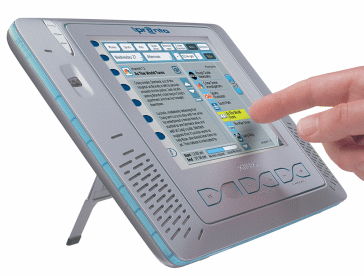Device profile: Philips iPronto digital home controller
Apr 15, 2003 — by LinuxDevices Staff — from the LinuxDevices Archive — 16 viewsThe Philips iPronto may well be a gadget-lover's dream come true. Ever glance around the family room in bewilderment at the number and diversity of remote controls required to make your entertainment systems go? If so, you might think you know why Philips created this brainy new remote. But getting rid of all those little button-studded black plastic battery-eaters isn't all this Linux-powered marvel aims to do.

Just try losing this remote control!
What's an iPronto do? As described by Philips: “the iPronto combines audio/video, home automation, and home network control capabilities in an easy-to-manage device that offers consumers a new solution for controlling a wide range of devices in the connected home.” Specifically, the device is supposedly able to control things like home theater components, lighting, security cameras, home networks, climate control, and, well, pretty much any other system or device in your home that it manages to hook up with via its IR/RF/Ethernet wired and wireless communications links.
Some interesting capabilities the iPronto can provide, according to Philips, include viewing electronic program guides, selecting media sources, browsing the web, and accessing email. And, lest we forget, the iPronto also performs “normal” remote control functions — so get ready to kiss all those old-fashioned little plastic battery-eaters goodbye!
In addition to providing a traditional infrared interface, the iPronto also implements Wi-Fi (802.11b) wireless connectivity and even an Ethernet port for LAN or broadband Internet access. In case that's not enough, there's also a USB port as well as an MMC/SD card slot for connecting to other devices (digital cameras?) and numerous other expansion and upgrade purposes.
While we haven't opened one up to look inside, we understand the iPronto's embedded computer is based on an Intel PXA250 XScale embedded processor. Its “customizable” graphical user interface consists of a “high-resolution” 6.4-inch touchscreen LCD, along with a group of stylish control buttons. The device also has a built-in microphone and stereo speakers which Philips says will allow users to listen to MP3s streamed from the Internet (and, presumably, from other home systems via some sort of home network), and which may some day enable futuristic uses such as voice recognition and IP telephony.
What can't this device do? Not much, we suspect, given its embedded Linux operating system, graphical touchscreen interface, and sophisticated communications capabilities. (Psst: there are even hints of future automotive applications.) Not surprisingly, Philips wisely made the iPronto's internal software field-upgradeable, and included a built-in OSGi service delivery platform (mBedded Server, from ProSyst).
Tao's Java Virtual Machine (JVM) provides a secure application execution environment.
And get this: we just learned that the iPronto will be on display in MontaVista Software's booth at the Embedded Systems Conference in San Francisco next week. Hmmm . . . we wonder whose embedded Linux it uses.
The iPronto, which earned the Best of Innovation Award at this year's Consumer Electronics Show (CES) in Las Vegas, is currently available in the US for a suggested retail price of $1699, and will reportedly be launched in Europe in the second half of 2003.
Learn more about the iPronto from the Philips Pronto family website.
This article was originally published on LinuxDevices.com and has been donated to the open source community by QuinStreet Inc. Please visit LinuxToday.com for up-to-date news and articles about Linux and open source.